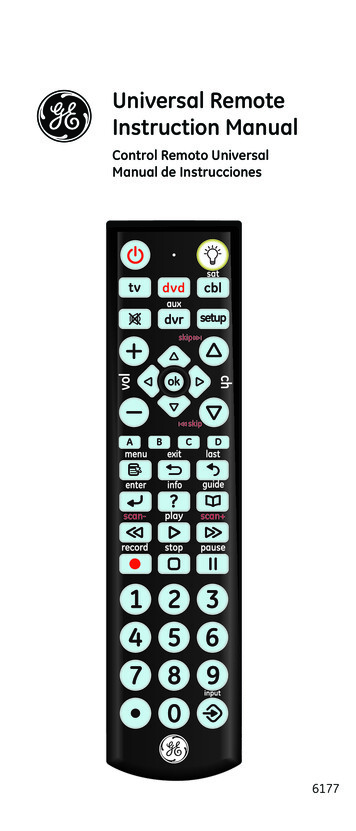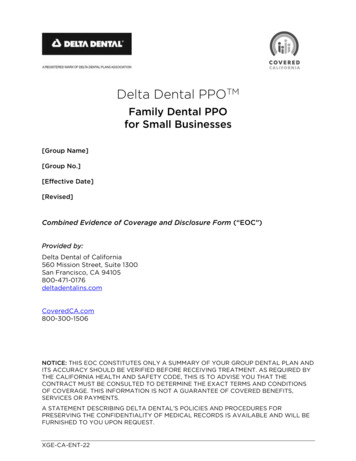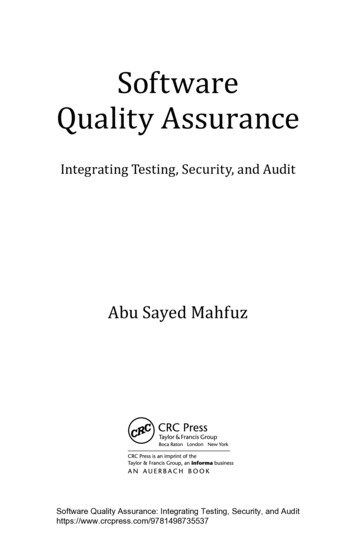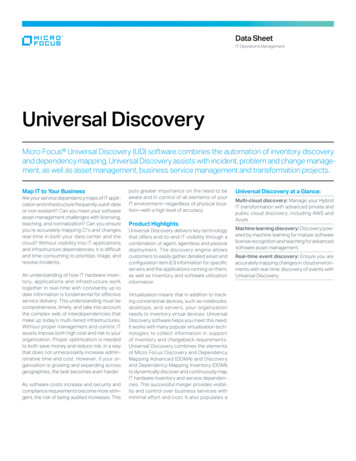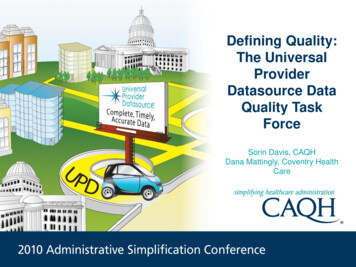
Transcription
Defining Quality:The UniversalProviderDatasource DataQuality TaskForceSorin Davis, CAQHDana Mattingly, Coventry HealthCare1
Agenda Introduction and Panelists.Data Quality Work Group:– Determining Objectives.– Recommendations. Data Quality Study:––––2FTI.Study Methodology.Outcomes.Next Steps.
Introduction and Panelists3 Dana MattinglyDirector, Operations SupportCredentials Verification Center, Coventry Healthcare Sorin DavisManaging Director, UPDCAQH
Provider Data Collection: CAQH ChallengeUPD (then UCD) was launched in 2002 to address the following: Redundancy: Providers are asked to complete multiple formsessentially requesting the same information. Follow-up: Omitted and illegible responses require significantresources and result in processing delays. Misalignment: Different credentialing cycles exacerbate the problemrequiring providers to complete the process at different points in time. Off-cycle updates: Follow-up required to maintain accurate databetween credentialing events so that provider directories, referrals,claims, and other provider and member services are in agreement. Turnaround: Providers are frustrated with time between applicationsubmission and when a decision is finally communicated.4
Provider Data Quality: The Issues Various departments throughout the enterprise need provider data:– Different needs.– Different data.– Different timeframes. Sources for provider data vary:––––– 5Provider self reported.Primary sources.Third party databases.Internal databases.Delegates.Consistency, timeliness and accuracy of data varies.
CAQH View of Provider DataNon-Payer Data RequirementsEnterprise Wide Data NeedsElements Required on Most Paper ApplicationsMinimum Required by Accreditation Organizations6
Provider Data Quality: CAQH/Lewin StudyThe Lewin Group was engaged to: Identify the current and potential use for provider information amongparticipating organizations. Identify barriers preventing wider use of CAQH’s data beyond currentuses. Make recommendations about how CAQH can achieve wideracceptance and uptake of the Universal Provider Datasource (UPD)initiative.7
Data Quality Work Group: ObjectivesCAQH created theData Quality Work Group tostudy and makerecommendations on how tovalidate and expand the use ofthe UPD data throughout theorganization.STUDYRECOMMENDENHANCE8
The Data Quality Work Group: Responsibilities 9Define and develop methods to confirm completeness, timeliness andquality of the provider data in the UPD.Identify what/how provider data is used throughout the health planenterprise.Identify additional data that is required for broader adoption andutilization of the UPD by participating organizations, including criticaldata elements common to all enterprise users.Summarize work group findings.Based on findings, recommend actions to improve and maintain theoverall data quality of the UPD; and determine the UPD dataapplicability and value throughout the organization.
Data Quality Work Group: Membership10
Data Quality Work GroupIdentified a comprehensive list of departments/functions within participatingorganizations that use provider data: 11CredentialingProvider DirectoryClaimsCommunicationsNetwork DevelopmentExternal Reporting FinanceMarketing/SalesMedical AffairsPharmacyProvider Data Management/ISCustomer Service
Data Quality Work Group Master List of Data Elements:– All fields on CAQH application.– Current requirement status: Required.Conditionally Required.Suggested.Optional.– Fields to consider adding in the future.12
Data Quality Work Group Work Group members analyzed the data elements and identified whichelements are “critical” to each of the departments/functions and whichare voluntary/optional.Conducted regulatory review of elements:– Group members volunteered to sub-committee.– Identify regulatory needs and UPD requirements.– Fields that are required by regulatory bodies and not already required byCAQH were identified as high priority. 13Defined list of 103 “critical” items to test quality of real data.
Data Quality Work Group Conclusion While a standard definition of providerdata accuracy does not exist, the workgroup determined that a transparent andstatistically valid study to determine thequality of UPD data was needed. CAQH commissioning an independentstudy to examine and validate thecompleteness and accuracy of the data inthe UPD, including: timeliness of UPD data and validation of provider data updates.14
UPD Data Quality Study CAQH retained FTI to conduct the data quality study:– FTI is a global consulting company with rich expertise in helpingorganizations enhance and protect their enterprise value, including deepstatistical analysis capabilities. Goals:– Provide an independent, objective and statistically valid assessment of UPDdata quality.– Identify opportunities to enhance UPD processes and controls to improvedata quality.– Create benchmark measures for future data quality assessments.– Develop a foundation for continuous data quality improvement.15
Study Methodology 16FTI conducted a large scale analyses of 205,132 active UPD physician records to assessdata completion rates and evaluate the logic and reasonableness of provider responses.–FTI further Identified a statistically valid sample size to analyze the accuracy of the key data fieldsidentified by the work group.–A statistically valid sample size was determined by first conducting a probe sample, asrecommended by DOH, HHS office of the Inspector General and CMS.–Validated accuracy of 3,360 UPD data fields, associated with 112 randomly selected providers.–This sample size produced statistically valid results within a plus or minus 1% range with a 95%confidence level.FTI then employed a combination of two research methods to determine data accuracy.–Use of publicly available information sources.–Direct outreach to providers.Accuracy was assessed in both “Absolute” and “Functional” terms.–Absolute data accuracy - exact match of every character of a data element to its independentsource.–Functional data accuracy - data match that is sufficient to achieve the intended purpose of thedata element.
Key Findings: UPD Completion Rates and ResponseLogic Findings confirmed that providers complete UPD questions at a highrate, regardless of whether answers are required by the system. Provider data subject to systemic logic testing confirmed that individualdata field entry integrity is high. The occurrence rate of fictitious entries,such as telephone numbers of 999-999-9999, is near zero ( 0.10%). Two categories of errors are notable:– 7.3% of providers re-attesting to their information failed to update expiredstate licenses.– 2.7% of providers had contradictory responses to related questions; forexample, answering “No” to accepting new patients, and subsequentlyanswering “Yes” to accepting new Medicare patients.17
Key Findings: UPD Data Element Review Results Study results indicate that the UPD provider data is 92.3% (absolute) to93.9% (functional) accurate. The majority of errors observed (80%) fit into five categories that CAQHcan be addressed with improved UPD data collection techniques.– Providers attested to outdated practice location and hospital affiliation (26% oferrors).– Incorrect practice name reporting (14% of errors).– Inconsistencies in state license information (20% of errors).– Inaccurate response to practice and provider languages spoken (13% of errors).– Erroneous responses to Medicare and Medicaid provider status (8% of errors). 18Improving the data quality in these five categories can increase overall dataaccuracy by as much as 4.9% (functional) to 6.2% (absolute) raising thepotential accuracy rates to 98.5% (absolute) and 98.8% (functional).
Key Findings: UPD Data Element Review Results –Details1. Providers attesting to outdated Practice and Hospital affiliationinformation:19 Detail: 26% of total errors were associated with providers who re-attestedbut failed to update practice location changes and/or changed hospitalaffiliations. Observation: Provider data is fluid and continuous systematic monitoringof non-date sensitive provider data changes is extremely difficult. Analysisof the providers with these data errors indicates that the information wasoriginally correct but the providers failed to update changes at time of reattestation. Initial Recommendation: Consider developing system edits/proceduresthat periodically prompt providers to review key data fields that can changeover time (such as primary practice locations and hospital affiliations).
Key Findings: UPD Data Element Review Results –Details – cont.2. Incorrect practice name: Detail: 14% of total errors were attributable to incorrect reporting of practice names.Observations: Providers are entering their own name rather than the name of theirpractice.Initial Recommendation: Improve UPD question wording and/or incorporate dataedit that triggers an alert to the provider to confirm when the practice name fieldcontains the provider’s name.3. Inconsistencies in state license information: Detail: 20% of the total errors were related to state license numbers not matchingonline state medical board data (12%) or incorrect license expiration dates (8%).Observation: Incorrect State license numbers are the result of two issues: state medical boards format licenses for on-line reports in a different manner than whatthe provider sees on the physical license. Expiration date errors are the result of providers attesting to outdated information. 20Initial Recommendation: Further analysis to determine why state on-line systemsreport license information in formats different than how reported on actualdocuments. Address expiration date errors through appropriate system edits at timeof re-attestation.
Key Findings: UPD Data Element Review Results –Details – cont.4. No response to practice and provider languages spoken fields: Detail: 10% of the total errors observed were related to instances in which noadditional language was indicated for the provider or their practice when, in fact,additional languages were spoken or translation services were available.Observation: This error was consistently a failure to respond to the question asopposed to incorrectly identifying languages spoken.Initial Recommendation: Create a required lead-in “Yes/No” question for both theprovider and practice name fields to guide providers into entering more information.5. Erroneous responses to Medicare and Medicaid provider status: 21Detail: 8% of the total errors observed were related to providers entering incorrectMedicare (2%) or Medicaid (6%) participating status.Observation: Possibility of provider confusion regarding these questions as well asthose that address whether or not new Medicare/Medicaid patients are accepted.Participation in some but not all managed Medicaid programs also created providerconfusion in responding correctly to Medicaid participation status.Initial Recommendation: Uncouple Medicaid and Medicare participationquestions from accepting new patient questions.
Initial Recommendations Summary22 Expand and enhance system edits and controls to alert providers ofexpired information at time of re-attestation. Explore system generated reminders/prompts for providers toperiodically review and confirm fields that can change over time suchas primary practice location and hospital affiliations. Refine unclear and/or ambiguous questions that can produceincomplete and/or inaccurate provider responses. Introduce more required lead-in “Yes/No” questions to increaseconsistency of responses in several existing questions (such aslanguages spoken). Conduct further analysis surrounding discrepancies between on-linestate license board data and licensure documents issued to providers.
Next Steps CAQH has made the data quality report publicly available for download:http://caqh.org/UPDDQreport.php23 CAQH and Work Group to prioritize recommendations for data qualityimprovement. CAQH and ACS to develop specifications for necessary systemmodifications, enchantments and process improvements. CAQH to identify necessary funding for development andimplementation. Implement modifications, enhancements and process improvements. Conduct additional data quality analyses to measure impact ofimprovements.
UPD Data Quality Study CAQH retained FTI to conduct the data quality study: -FTI is a global consulting company with rich expertise in helping organizations enhance and protect their enterprise value, including deep statistical analysis capabilities. Goals: -Provide an independent, objective and statistically valid assessment of UPD







